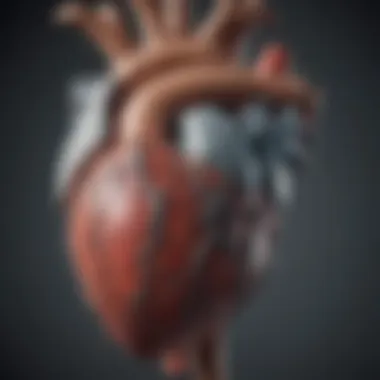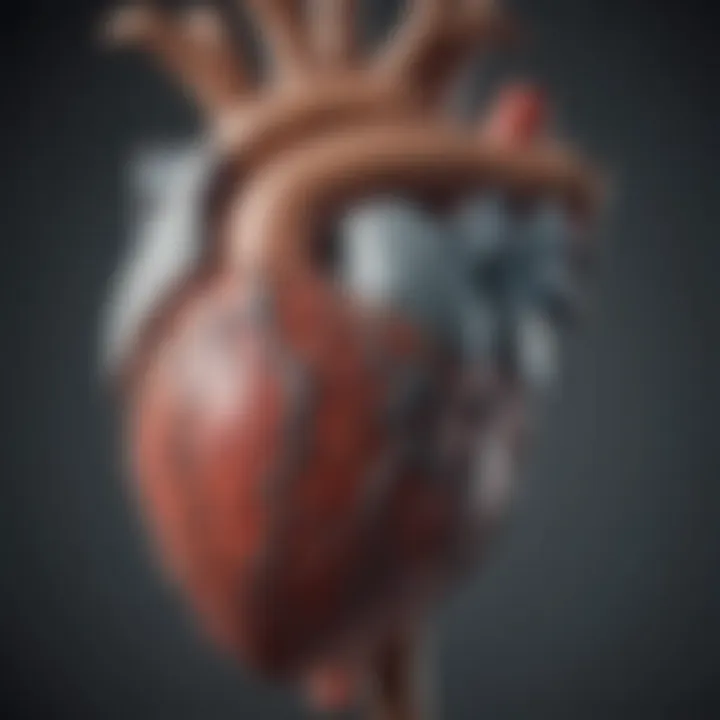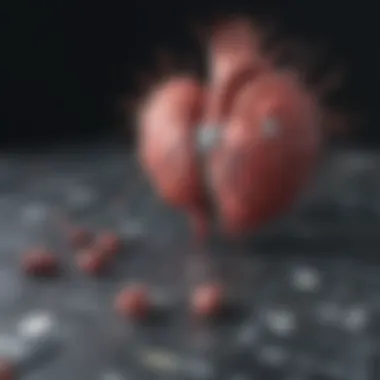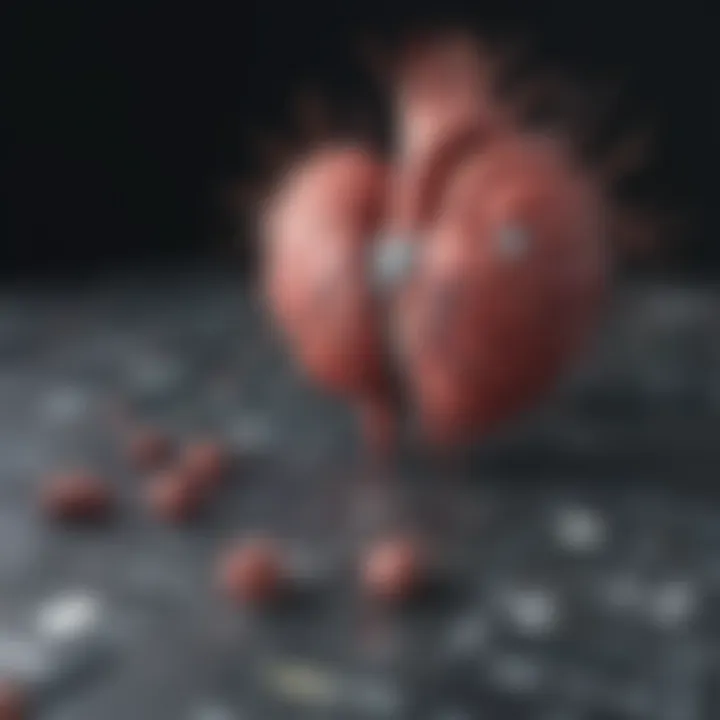Exploring the QRS Complex in ECG Interpretation


Intro
Electrocardiography is a crucial diagnostic tool in the assessment of heart health, providing a graphical representation of the heart's electrical activity. Central to this analysis is the QRS complex, which reflects the depolarization of the ventricles—essentially, the heart's main pumping chambers. Understanding the nuances of the QRS complex is paramount for medical professionals and students alike, as alterations in its morphology can signal various cardiac pathologies.
This complex does not merely represent electrical activity but encapsulates a story about the heart's function and health. From the steep, pointed peaks of the QRS to the duration and width of its descent, each characteristic can offer insights into the underlying conditions affecting patient care.
Diving deep into the specifics of the QRS complex, one will uncover its physiological basis, structural intricacies, and the clinical implications tied to its variations. As technology advances, methods for analyzing the QRS continue to evolve, enhancing our ability to diagnose and treat cardiac conditions effectively.
Through this journey, the significance of the QRS complex becomes clearer—not just as a feature of the ECG, but as a vital indicator of one's overall cardiac health.
Key Findings
Summary of the main results
Upon thorough exploration of the QRS complex, several key findings emerge that underscore its importance in the realm of cardiology:
- Morphological Variations: The shape, duration, and amplitude of the QRS complex can indicate conditions such as myocardial infarction, hypertrophy, and bundle branch blocks.
- Clinical Applications: Anomalies in the QRS are utilized to stratify risk in various populations, guiding treatment plans for patients with cardiovascular diseases.
- Technological Advances: Modern analysis techniques, including machine learning algorithms, have enhanced the precision in detecting QRS abnormalities, allowing for earlier and more accurate diagnoses.
Significance of findings within the scientific community
The insights gained from understanding the QRS complex have far-reaching implications.
"The QRS complex serves as a window into the heart's workings, often revealing issues that may otherwise remain hidden."
Its morphology can be an early warning signal for life-threatening conditions, prompting timely intervention. Moreover, as the field of electrophysiology matures, the integration of these findings into clinical practice continues to evolve, shaping the future of cardiac care.
Implications of the Research
Applications of findings in real-world scenarios
The knowledge of the QRS complex is not confined to textbooks or laboratories but extends into various real-world applications:
- Emergency Medicine: Rapid interpretation of the QRS complex can be crucial in emergency settings, allowing healthcare providers to act quickly in cardiac arrest situations.
- Long-Term Monitoring: Devices like wearable ECG monitors can track QRS changes over time, providing valuable data for managing chronic heart conditions.
- Patient Education: Understanding the implications of the QRS complex can empower patients to engage actively in their cardiac health monitoring.
Potential impact on future research directions
The diligent study of the QRS complex opens avenues for future research, particularly in areas like:
- Genetic Correlations: As genetics fields intersect with cardiology, there lies potential for identifying inherited factors that distort the normal QRS morphology.
- Holistic Approaches: Future studies may also explore how lifestyle changes and environmental factors influence the QRS characteristics, potentially leading to preventative strategies in heart disease.
Preamble to Electrocardiography
Electrocardiography, or ECG, plays a pivotal role in the comprehensive assessment of cardiac health. At its core, ECG provides insights into the electrical activities of the heart, facilitating the diagnosis of various cardiovascular conditions. Understanding this field becomes increasingly important as advancements in medical technology transition from traditional methods to more innovative solutions. Academics, healthcare professionals, and even patients can benefit from grasping the fundamentals of this vital diagnostic tool.
The significance of ECG in cardiology cannot be overstated. It holds the ability to reveal abnormalities in heart rhythm, chamber enlargement, and even signs of ischemia, all of which can lead to serious health concerns if overlooked. By translating the heart's electrical impulses into a visual representation, physicians can spot issues that may not be apparent through other means. The accessibility of this technology aids in timely interventions, ultimately promoting better patient outcomes.
The Role of ECG in Cardiology
The heartbeat is more than just a rhythmic thump; it’s a complex dance of electrical signals. ECG helps catch this performance, allowing us to peek behind the curtain of cardiac events. For instance, a simple 12-lead ECG can uncover various pathologies—be it atrial fibrillation, ventricular hypertrophy, or signs that point towards potential heart attacks. Without this diagnostic tool, many conditions might remain hidden until they evolve into more severe issues.
Notably, the use of ECG extends beyond mere diagnosis. It also offers a valuable framework for monitoring ongoing heart conditions, assessing the effects of medications, and determining the success of surgical interventions such as bypass surgeries or stent placements. In emergency settings, it forms the backbone of quick decision-making, guiding clinicians in their treatment strategies.
History of ECG Development
To appreciate the significance of ECG today, it helps to reflect on its historical evolution. The groundwork was laid in the late 19th century when Willem Einthoven first introduced the concept of electrocardiography. His use of a string galvanometer allowed for the recording of electrical heart activity, setting the stage for future advancements.
Over the years, innovations in technology transformed the initial rudimentary devices into today's sophisticated ECG machines. The shift from bulky, stationary units to portable handheld devices has revolutionized how clinicians operate. The advent of digital ECG further opened doors, allowing for precise interpretations and the possibility of remote monitoring, thus broadening access to cardiac care.
The Anatomy of the QRS Complex
The QRS complex is a fundamental aspect of the electrocardiogram (ECG), representing the electrical activity during ventricular depolarization. Understanding its anatomy is critical for several reasons: it aids in the interpretation of cardiac function, helps in diagnosing various cardiac abnormalities, and provides insight into the heart's overall health. A comprehensive grasp of the QRS complex's components can illuminate how variations in its morphology can signal underlying pathologies. In essence, knowing the structure of the QRS complex equips clinicians with a powerful tool in cardiology.
Components of the QRS Complex
The QRS complex comprises three main waves: the Q wave, the R wave, and the S wave. Each of these components plays a unique role in reflecting the heart's electrical conduction and offers a different perspective on cardiac health.
Q Wave
The Q wave typically appears as a downward deflection following the P wave and indicates the initial phase of ventricular depolarization. Its significance lies not just in its presence or absence but also in its morphology. A normal Q wave is thin and short, representing a small electrical impulse as the electrical wave moves through the interventricular septum. In this article, recognizing the abnormalities associated with Q waves can be very beneficial. For instance, the presence of abnormal Q waves may signal previous myocardial infarction or other heart issues.
Important Note: Abnormalities in the Q wave can often be a red flag in an ECG reading, demanding further investigation.


R Wave
The R wave is the most prominent part of the QRS complex, characterized by a robust upward deflection. It indicates the main phase of depolarization of the ventricles. The amplitude of the R wave can provide valuable insight into the volume of muscle mass in the ventricles. In fact, a larger-than-normal R wave can point towards left ventricular hypertrophy. Essentially, the R wave holds great clinical importance due to its direct correlation with heart muscle function, making it a pivotal point in our analysis.
S Wave
Following the R wave, the S wave presents another downward deflection, completing the QRS complex. Its role, although often overshadowed by the R wave, is equally vital. The S wave signals the final phase of ventricular depolarization, and changes in its depth or duration can indicate various heart conditions, including bundle branch blocks. An exaggerated S wave might be of interest when considering conditions related to right ventricular hypertrophy or ischemia.
Normal Duration and Amplitude
The typical duration of a QRS complex ranges between 0.06 to 0.10 seconds, while its amplitude varies widely depending on several factors such as the lead used for measurement and the patient's body mass. A prolonged QRS duration can imply an underlying conduction delay or myocardial dysfunction. Being aware of normal values is crucial in detecting abnormalities that could lead to serious health implications. Understanding how these parameters achieve their significance enhances not only your investigative skills but also your interpretations as you navigate through each ECG reading.
Physiological Basis of the QRS Complex
Understanding the physiological basis of the QRS complex helps establish a clear connection between electrical activities in the heart and their representation on an electrocardiogram (ECG). The QRS complex consists of a series of electrical impulses triggered by various cardiac events that make it crucial in assessing heart health. It primarily reflects the depolarization of the ventricles, which is a critical phase in cardiac function. It also plays a key role in determining the efficiency of blood circulation.
Cardiac Action Potentials
The heart's ability to function effectively hinges on the generation and propagation of cardiac action potentials. These electrical signals arise from specialized cells known as cardiomyocytes. When a heart cell depolarizes, it causes a rapid influx of sodium ions, which leads to a spike in electrical activity. This phenomenon can be broken down into several phases:
- Phase 0: Initial depolarization occurs due to sodium channels opening, causing a rapid increase in voltage.
- Phase 1: The sodium channels inactivate, and potassium channels open, initiating repolarization.
- Phase 2: This plateau phase sees calcium channels open, balancing depolarization and repolarization, and prolonging action potential duration.
- Phase 3: Calcium channels close while potassium channels remain open, bringing the cell back to its resting state.
Overall, these action potentials coalesce to form the QRS complex seen on an ECG, allowing clinicians to monitor heart function effectively. It’s vital to note that any abnormality in action potential duration or shape can result in an irregular QRS complex, indicating underlying cardiac issues.
Conduction Pathways in the Heart
The heart's conduction system is a finely-tuned network that ensures the synchronized contraction of its chambers. This system comprises several key components:
- Sinoatrial (SA) Node: Known as the heart's natural pacemaker, this node generates the impulse that begins the cycle of contraction.
- Atrioventricular (AV) Node: It serves as a gatekeeper, temporarily slowing the electrical signal before it travels to the ventricles, ensuring proper timing between atrial and ventricular contractions.
- Bundle of His: This pathway branches into the right and left bundle branches, directing impulses toward the ventricles.
- Purkinje Fibers: These fibers ensure that the contraction signal propagates quickly and uniformly throughout the ventricles.
The conduction pathways contribute significantly to the QRS morphology on the ECG. Variations or blocks in any of these pathways can affect the normal shape and duration of the QRS complex, thus providing important diagnostic clues.
The QRS complex is not merely a representation of electrical activity; it is a composite of the heart's rhythmic cadence, embodying the intricate coordination required for effective blood circulation.
QRS Morphology Variants
The QRS complex plays a pivotal role in diagnosing various cardiac conditions. This section delves into the different variants of the QRS morphology, shedding light on their significance in clinical practice. Variations in the shape and size of the QRS complex can indicate underlying health issues or variations in heart physiology. Understanding these variants not only aids in accurate diagnosis but also enhances the evaluation of a patient's cardiac health.
Normal Variants
In the realm of electrocardiography, not every alteration in the QRS complex signifies pathology. There are normal variants which can arise due to factors such as age, gender, and physical conditioning. For instance, athletes often display a QRS morphology that differs from the general population, stemming from their enhanced cardiac function. This emphasizes the significance of context when analyzing an ECG.
Some common normal variants include:
- A taller R Wave in leads V5 and V6, mainly in younger adults or athletes.
- Wide QRS complexes which can be observed in children, typically resolving with age.
- Q waves in leads I, aVL, or V6 that can be seen without any underlying pathologic significance in some individuals.
These normal variations, while benign, require careful assessment to ensure they are not mistaken for signs of underlying cardiac issues.
Clinical Significance of Abnormal Morphology
When we shift focus to abnormal QRS morphology, the implications become significantly more profound. Abnormalities in the QRS complex morphology can unveil critical cardiac disorders. Below, we explore three notable conditions characterized by distinct QRS changes:
Left Bundle Branch Block
A left bundle branch block (LBBB) presents as a hallmark of some underlying cardiac disorders. Among its key characteristics is the prolongation of the QRS duration to over 120 milliseconds. This can be observed in leads I, aVL, V5, and V6, manifesting a notched R wave. The presence of LBBB is crucial as it can signal left ventricular systolic dysfunction and poor prognostic outcomes in patients.
One unique feature of LBBB is its ability to mask other abnormalities on an ECG, particularly those indicative of myocardial ischemia. This underscores the importance of distinguishing it from other forms of conduction abnormalities.
Right Bundle Branch Block
Conversely, a right bundle branch block (RBBB) exhibits a distinct morphology, represented by an RSR' pattern in V1 and V2, along with a wider QRS complex. Although RBBB can occur in healthy individuals, its presence in conjunction with abnormalities in other leads can signal right ventricular hypertrophy or ischemia.
This variant is often less concerning than LBBB, but should still be approached with caution. Evaluating the context in which RBBB occurs is essential, as it might have implications about the patient's overall cardiac health.
Myocardial Infarction
Myocardial infarction (MI) typically manifests on the ECG with ST segment elevation or depression, but can also demonstrate pathological Q waves. These Q waves often signify infarction of varying ages; older MIs can show significant Q wave changes in specific leads based on the region of the heart affected.
Identifying these abnormal Q waves is critical, as their presence can inform on the timing and extent of myocardial injury. This allows for appropriate intervention to be implemented, potentially reducing morbidity and mortality associated with acute coronary events.
The early recognition of QRS morphology changes plays a crucial role in effective management of cardiac conditions.
In summary, understanding QRS morphology variants is not only important for identifying normal physiology versus pathology but is also paramount in guiding clinical decisions. By appreciating these nuances, healthcare professionals can provide timely and effective care to those with cardiac concerns.


Methods of QRS Analysis
Methods of QRS analysis play a critical role in understanding cardiac health through electrocardiography. These techniques can be broadly classified into manual interpretation techniques and automated ECG analysis systems. Each has its own unique features and benefits, which cater to various healthcare settings and practitioner needs.
Manual interpretation involves the clinician actively examining the ECG readings. This traditional method allows for a deep understanding of the electrical activities of the heart and can capture nuances that machines might overlook. Manual interpretation is not just about identifying the morphology of the QRS complex; it also includes assessing rhythm, rate, and other related parameters. The analyst can draw on their clinical experience to make informed decisions based on the specific details of an individual's ECG.
"Understanding the morphology of the QRS complex is essential for diagnosing a variety of cardiac conditions, from transient ischemia to more chronic states like cardiomyopathy."
In contrast, automated ECG analysis systems use algorithms to process ECG data rapidly. These systems can be particularly useful in high-throughput environments such as emergency rooms where time is of the essence. They typically rely on pattern recognition and machine learning to flag irregularities in the QRS complex morphology, providing immediate feedback. However, this speed can sometimes come at the expense of depth, as these systems may not completely replicate the nuanced judgment of a seasoned clinician.
Manual Interpretation Techniques
Manual interpretation techniques rely heavily on the practitioner's skill and experience. The process generally involves the following steps:
- Systematic approach: Clinicians often use a systematic methodology to read ECGs. This includes analyzing the P wave, QRS complex, T wave, and overall rhythm. A methodical approach minimizes the risk of missing crucial abnormalities.
- Detail-oriented observation: The analyst closely examines the size, shape, and duration of the QRS complex. Variations can signal underlying heart conditions.
- Contextual evaluation: Important clinical context, such as the patient’s history and symptoms, informs the interpretation and can guide further testing if necessary.
Despite its merits, manual interpretation can be time-consuming and may depend on the individual's level of expertise. As with any skill, experience greatly enhances a clinician's ability to detect subtle variations that could indicate significant pathology.
Automated ECG Analysis Systems
Automated ECG analysis systems have revolutionized the way healthcare professionals interpret QRS complexes in patients. Consider the following aspects:
- Speed and Efficiency: These systems analyze ECG recordings almost instantaneously, providing quick results in acute settings, which can be lifesaving.
- Standardized Criteria: Many of these systems use universal criteria for detecting abnormalities, which can help ensure consistency across evaluations.
- Integration with Electronic Health Records: Newer systems can be integrated with patient records, facilitating a smooth continuum of care and historical comparisons.
However, it’s essential to approach automated systems with caution. Although they offer efficiency, they are not infallible. Misinterpretations can occur, especially in complex cases where the algorithms may have limitations.
The choice between manual and automated systems often depends on the clinical scenario, available resources, and the experience level of the interpreting clinician. Ideally, the two methods can complement each other, providing a full picture of the patient’s cardiac health.
Clinical Implications of QRS Complex Interpretation
Understanding the QRS complex isn't just an academic exercise; it's a vital piece of the puzzle in diagnosing heart conditions. The QRS complex, which represents the electrical impulses that initiate the contraction of the ventricles, does not operate in isolation. An accurate interpretation of its morphology can lead to significant insights into a patient's cardiac status. This section elaborates on how assessments of this component have far-reaching implications for patient care and outcomes.
Assessment of Cardiac Conditions
When physicians assess the QRS complex during an electrocardiogram, they are looking at more than just a squiggly line. Each wave can signify underlying issues, from benign variations to serious ailments that require immediate attention. The QRS morphology gives clues about the overall health of the heart and can aid in diagnosing various conditions such as:
- Myocardial Infarction: Changes in the QRS complex can be indicative of past or ongoing heart attacks. Abnormalities like deep Q waves might point towards damage that has occurred, while other changes can suggest acute distress.
- Bundle Branch Block: A right or left bundle branch block manifests as a widening of the QRS complex. This delay in ventricular conduction may suggest structural heart issues.
- Cardiomyopathy: Variations in QRS patterns can help detect different types of cardiomyopathies, where the heart muscle becomes enlarged, thickened, or stiffened.
- Arrhythmias: Abnormal QRS complexes may also indicate arrhythmic conditions, which can lead to a range of symptoms, from palpitations to syncope.
By carefully analyzing the QRS duration, morphology, and axis, clinicians can gather essential data to either confirm a diagnosis or guide further tests.
Prognostic Value of the QRS Complex
The prognostic value of the QRS complex extends beyond immediate diagnosis. A thorough interpretation can provide insights into potential future occurrences of serious cardiac events. For instance, studies have shown that:
- A prolonged QRS duration is often correlated with a higher risk of adverse outcomes in patients with heart disease.
- Changes in QRS morphology can signify ventricular hypertrophy, which has been associated with an increased risk for cardiovascular-related morbidity.
- Patients who present with specific QRS patterns may need more intensive monitoring and management, implying a direct influence on treatment plans and decisions.
"The QRS complex holds answers that can guide our interventions and improve heart health for many." – Cardiology Expert
Clinical interpretations of the QRS complex will undoubtedly evolve with advances in technology, but its foundational role in assessing cardiac conditions could never be overstated. The insights gleaned from this simple yet complex feature of the electrocardiogram can shape treatment paths and predict patient outcomes in significant ways.
Advanced Technologies in ECG Interpretation
The rapid evolution of technology has transformed many facets of healthcare, and electrocardiography is no exception. Advanced technologies in ECG interpretation elevate the standard of cardiac assessment, enabling more precise and thoughtful evaluations. This section emphasizes the significance of these advancements and their implications for patient care and outcomes.
Wearable ECG Monitors
Wearable ECG monitors have emerged as a game-changer in the monitoring and management of cardiac health. Unlike traditional ECG machines that may restrict patients to clinical settings, these devices allow real-time tracking of heart rhythms in everyday life. Here are some key points about wearable ECG monitors:
- Continuous Monitoring: Patients can obtain data over days or weeks, capturing potential arrhythmias that might go unnoticed during brief clinical assessments.
- User-Friendly Designs: Devices like smartwatches and patches offer intuitive interfaces, making it easy for patients to manage their own heart health.
- Data Sharing: Many wearable devices allow data to be shared seamlessly with healthcare professionals, enhancing the dialogue between patient and provider.
"The ability to monitor one’s own heart rhythm not only empowers patients but also provides clinicians with a wealth of information for better decision-making."
However, there are considerations to bear in mind:
- Data Privacy: As with all technology, the importance of securing patient data cannot be overstated. Patients must be informed about where their data is stored and how it is used.
- Accuracy: Not all wearable monitors offer the same level of accuracy as traditional ECGs. It’s critical that users discern the limitations of their devices, especially when it comes to diagnosing serious conditions.
Artificial Intelligence in ECG Analysis
Artificial intelligence (AI) is making significant strides in the field of ECG interpretation. With the increasing demand for efficient and accurate cardiac assessment, AI tools assist healthcare professionals by enhancing analysis speed and precision. Here’s how AI contributes to ECG interpretation:
- Pattern Recognition: AI algorithms are adept at recognizing complex patterns in the QRS complex, allowing for the identification of abnormal morphologies that may be challenging for human observers to detect.
- Predictive Analytics: AI can analyze historical data to forecast potential cardiac events, providing clinicians with valuable insights into patient prognosis.
- Reducing Workload: By automating interpretation tasks, AI frees up healthcare professionals to focus on more nuanced aspects of patient care, thus improving overall efficiency.
Considerations must also be weighed:


- Reliability: While AI offers significant promise, it is paramount that these systems undergo rigorous validation to ensure their reliability in clinical settings.
- Human Oversight: AI should be viewed as an adjunct to, not a replacement for, human expertise. The final interpretation should always involve a trained healthcare provider.
With advancements like wearable ECG monitors and AI, the landscape of cardiac health monitoring is continually evolving. These technologies not only improve the experience for patients but also assist healthcare professionals with data that leads to informed decisions. The intersection of technology and cardiac care holds great promise for better health outcomes.
Global Perspectives on Cardiac Health and ECG Use
In the landscape of healthcare, the accessibility of electrocardiogram (ECG) technology emerges as a pivotal theme. Not only does it serve as a diagnostic tool but also shapes public health strategies globally. Understanding how ECGs fit into broader cardiac health initiatives is critical. This section explores various factors including accessibility, training of healthcare professionals, and the integration of technology in cardiac care.
Access to ECG Technology Worldwide
Access to ECG technology across different regions varies significantly. In high-income countries, ECG machines are primarily standard equipment in both hospital and primary care settings. However, in lower-income countries, the scenario is less straightforward. Many healthcare facilities lack basic ECG capabilities due to high costs, limited infrastructure, or a shortage of qualified personnel.
Key considerations include:
- Economic disparities: The cost of acquiring and maintaining ECG machines can be a barrier in resource-limited settings.
- Geographical challenges: Rural areas may struggle to obtain essential cardiac monitoring equipment.
- Public health policies: Countries with coherent health policies tend to establish programs aimed at improving cardiac care and making ECG access more widespread.
"Access to intermediate and primary care ECG technology has shown to significantly decrease cardiovascular mortality in underserved populations."
Efforts are being made to overcome these hurdles, such as telemedicine initiatives and portable ECG systems that cater to remote areas. For instance, mobile health applications allow for real-time ECG transmission, facilitating diagnosis in places where traditional machines are not available.
Training Healthcare Professionals in ECG Interpretation
In tandem with accessibility, adequate training for healthcare professionals is paramount. Proper understanding of ECG interpretation cannot be overstated; the complexity of cardiac rhythms requires a robust foundational education. While many medical schools include ECG training in their curricula, the depth and quality of this training can differ substantially around the world.
Important aspects of training include:
- Curriculum development: Training programs should address not only basic interpretation but also advanced analysis, including understanding the QRS complex in depth.
- Continuous education: Ongoing education is vital, especially with advancements in technology and evolving clinical guidelines.
- Hands-on experience: Simulation-based learning and workshops provide invaluable experience for healthcare providers.
The establishment of international partnerships and online learning platforms is enhancing training opportunities, allowing professionals from diverse backgrounds to learn and improve their skills. Efforts to incorporate culturally relevant case studies also help in making learning more relatable and effective.
In summary, understanding global perspectives on cardiac health, especially concerning ECG technology, highlights the interconnectedness of accessibility and professional training. By improving these areas, healthcare systems can better address the challenges of cardiac health management, benefiting populations around the world.
Future Directions in QRS Research
As we dive into the future of QRS research, it's clear this topic holds great significance in the ongoing exploration of cardiac health. The complexities involved in the QRS complex make it not just a point on an ECG, but a window into the heart's behavior and overall function. The continuous pursuit of knowledge in this area is vital for improving diagnostics and treatment methods relating to heart disease. Here, we will discuss emerging research areas and potential innovations that are likely to shape the next chapters in how we interpret and understand the QRS complex in electrocardiography.
Emerging Research Areas
Research surrounding the QRS complex is expanding rapidly, fueled by technological advancements and an increasing understanding of cardiac physiology. Some notable areas that researchers are focusing on include:
- Genetic Factors in QRS Variants: Understanding the genetic underpinnings of different QRS morphologies could lead to better prognostic tools for patients.
- Electrophysiological Modeling: Modeling how electrical impulses travel through the heart can illuminate paths to new treatments for arrhythmias. This modeling often involves complex algorithms to mimic real-world conditions accurately.
- Longitudinal Studies: Following patients over time to assess how variations in QRS morphology correlate with clinical outcomes can provide robust data that might shift current practices.
- Wearable Technology: Research into how wearable ECG monitors can integrate seamlessly into everyday life is emerging, paving the way for continuous health monitoring.
These areas aren't just academic; they hold real promise for enhancing patient care. Understanding these factors will likely contribute to personalized medicine, allowing for tailored treatments based on individual cardiac profiles.
Potential Innovations in ECG Technology
In tandem with emerging research areas, innovations in ECG technology are progressing rapidly. These advancements promise to transform how QRS complex is interpreted:
- Integration of AI: Artificial Intelligence is being harnessed to analyze ECGs with unprecedented accuracy. AI can help assess QRS morphology quickly, catching anomalies that a human eye might overlook.
- Remote Monitoring Solutions: Technology is bridging distances, allowing patients to undergo QRS analysis remotely. This is particularly critical for individuals in rural areas or those with mobility challenges.
- Real-time Data Analysis: Future ECG devices could potentially provide immediate insights during diagnostic procedures. This immediacy could lead to quicker interventions when abnormalities are detected.
- Enhanced User Interface Designs: With intuitive designs in software, both laypeople and healthcare providers can navigate ECG data more efficiently, making it easier for anyone to grasp complex information about their heart health.
The fusion of research with these technological advancements creates a fertile ground for breakthroughs in cardiac health management. As technology progresses, we may discover new implications tied to the QRS complex that elude us today.
In summary, the focus on future directions in QRS research is not merely for academic curiosity. It is about enhancing lives through better diagnosis, understanding, and treatment of heart conditions. The integration of various innovations can also ensure that practitioners have the best tools at their disposal to interpret cardiac health accurately.
The End
In summarizing the significance of the QRS complex in electrocardiography, it’s clear that this component serves as a crucial marker for understanding cardiac health. The interpretation of the QRS complex allows healthcare professionals to assess various cardiac conditions and play a pivotal role in timely diagnoses. It’s more than just electrical patterns—it serves as a window into the heart's functioning and potential issues.
The QRS complex encapsulates essential insights into the heart's electrical system, revealing information about its anatomy and physiology. Abnormalities in its morphology can hint at underlying diseases such as myocardial infarction or bundle branch blocks. Active monitoring of the QRS complex can indeed be life-saving, especially in acute care settings where every heartbeat counts.
Additionally, as technology advances, the tools available for analyzing the QRS complex are becoming increasingly sophisticated. Automated systems and AI-driven solutions add layers of accuracy and efficiency, reshaping how cardiologists interpret ECG findings.
"The power of the QRS complex lies in its ability to inform and influence clinical decisions."
Ultimately, grasping the nuances of the QRS complex is vital—not only for medical professionals but for anyone interested in advancing cardiac care and enhancing patient outcomes.
Summary of Key Insights
The key takeaways from the discussions surrounding the QRS complex include:
- Understanding the Structure: Recognizing the individual components of the QRS complex—Q waves, R waves, and S waves—provides foundational knowledge for analysis.
- Clinical Importance: Abnormalities in the QRS complex offer insights into various heart conditions, forming the basis for diagnosis and treatment plans.
- Technological Advances: Innovations like artificial intelligence and wearable ECG monitors are changing the landscape of cardiac monitoring, providing real-time analysis and observations.
- Educational Value: Training healthcare professionals in ECG interpretation is paramount, ensuring accurate readings and informed clinical decisions.
- Global Health Perspective: Access to ECG technology is still uneven globally, highlighting the need for improved training and resources in remote or underserved areas.
The Importance of Ongoing Research
Research in the realm of QRS complex analysis is essential for numerous reasons:
- Enhanced Diagnostic Tools: New studies can lead to the development of more precise and reliable diagnostic tools.
- Understanding Kardiological Anomalies: Continued exploration helps to deepen the understanding of complex cardiac anomalies and their implications on overall health.
- Improved Patient Care: Ongoing research directly contributes to better patient outcomes through informed clinical practices and improved guidelines.
- Integration of Emerging Techniques: As medical science evolves, integrating fresh findings from genetics, informatics, and mobile health could revolutionize how cardiologists approach the QRS complex.
- Global Health Initiatives: Investing in research might pave the way for techniques that can be adapted and utilized in regions with limited access to cardiac care.
The journey of understanding the QRS complex is ongoing. With every bit of new research and technological advancement, the potential to impact patient care increases, making the need for diligent exploration in this field more pressing than ever.







